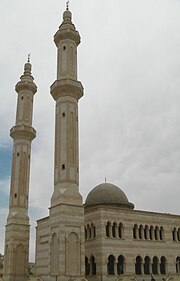A'zaz
|
Azaz أعزاز |
|
|---|---|
 |
|
| Location in Syria | |
| Coordinates: 36°35′10″N 37°2′40″E / 36.58611°N 37.04444°E | |
| Country |
|
| Governorate | Aleppo Governorate |
| District | A'zaz District |
| Nahiyah | Azaz |
| Elevation | 560 m (1,840 ft) |
| Population (2004) | |
| • Total | 31,623 |
| Time zone | EET (UTC+2) |
| • Summer (DST) | +3 (UTC) |
Azaz (Arabic: أعزاز A‘zāz, Hurrian: Azazuwa, Neo-Assyrian: Ḫazazu, Old Aramaic: Ḥzz) is a city in northwestern Syria, roughly 20 miles (32 kilometres) north-northwest of Aleppo. According to the Syria Central Bureau of Statistics (CBS), Azaz had a population of 31,623 in the 2004 census. As of 2015[update], its inhabitants were almost entirely Sunni Muslims, mostly Arabs but also Kurds and Turkmen.
It is historically significant as the site of the Battle of Azaz between the Crusader States and the Seljuk Turks on June 11, 1125. It is notable for its proximity to a Syrian–Turkish border crossing, which enters Turkey at Oncupinar, south of the city of Kilis.
In excavations of the site of Tell Azaz, considerable quantities of ceramics from the early and middle Islamic periods were found. Despite the importance of Azaz as indicated by archaeological finds, the settlement was rarely mentioned in Islamic texts prior to the 12th century. However, a visit to the town by the Muslim musician Ishaq al-Mawsili (767–850) gives some indication of Azaz's importance during Abbasid rule. The Hamdanids (945–1002) built a brick citadel at Azaz. It was a square fortress with two enclosures, situated atop a tell. Azaz became the scene of a humiliating defeat of the Byzantine emperor Romanos III at the hands of the Mirdasids in August 1030.
...
Wikipedia

